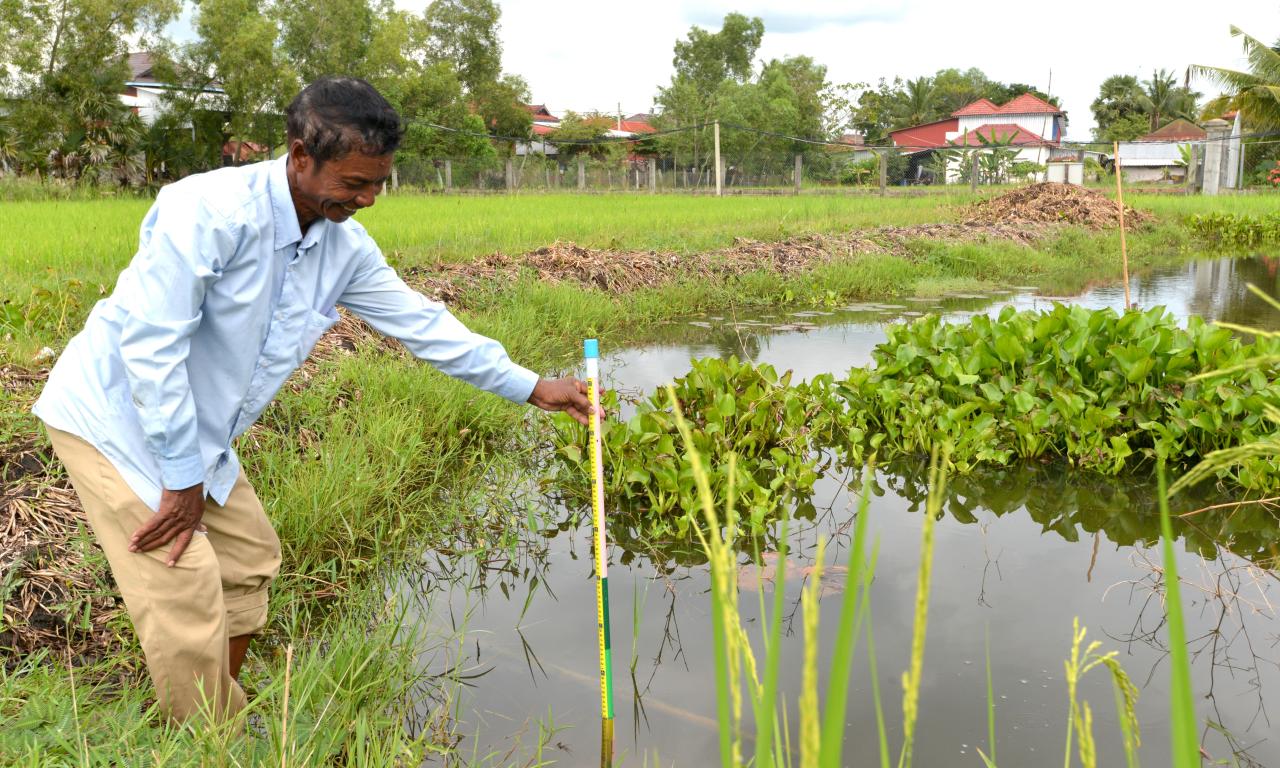
Rice-field fisheries (RFF) have long been a cornerstone of Cambodia’s rural landscape, sustaining both livelihoods and food security. As climate change intensifies and resource availability fluctuates, innovative approaches are needed to ensure that these systems continue to support communities effectively. In response, the CGIAR Initiative on Asian Mega-Deltas (AMD) has initiated experiments focused on enhancing the potential of arice-field ponds, a vital component of RFF. These initiatives aim to improve rural incomes, food security, and climate resilience, ultimately ensuring that Cambodia’s agricultural systems can thrive during the challenges of a changing climate.
Under AMD’s Work Package 1, the initiative has emphasized scalable innovations that strengthen resilient, diversified production systems. Rice-field ponds, located within rice fields, play a critical role in sustaining fish populations during droughts and the wet season. These ponds provide much-needed resources for household income and food security, as farmers can harvest fish after the rice season to support their livelihoods. Through such integrated systems, farmers not only secure food for their families but also diversify their sources of income, helping them weather climate-related uncertainties.
Improving Productivity and Profitability
The AMD experiment, which compared traditional and improved rice-field pond practices, showed that climate-resilient interventions significantly boosted productivity and profitability. Key improvements included adding inlets and outlets to connect ponds with rice fields, promoting fish migration and water exchange. Aquatic plants covering 30%-40% of the pond area supported biodiversity, while shelters protected fish and prevented illegal activities. These changes enhanced fish growth, biodiversity, and overall system productivity.
By optimizing ponds, farmers can enjoy increased rice cultivation cycles and a steady fish supply, which in turn enhances food security and provides income stability, even in the face of variable rainfall and water scarcity.
- Increased Yields: The improved rice-field pond systems contributed to a remarkable 57% increase in rice yield and a 67% increase in fish production. Farmers saw around 65 kg of fish per pond and 3.45 tons of rice per hectare per cycle.
- Economic Insights: Both the control and treatment rice-field ponds proved profitable, but the treatment ponds showed a clear economic advantage. Fish profits in treatment ponds increased up to USD 42 per 100 m², while rice profits rose by approximately USD 3 per 100 m².
- Cultivation Cycles: Farmers utilizing rice-field ponds typically achieve at least 2 cultivation cycles annually, leveraging pond water to improve both climate resilience and profitability.
- Species Composition: Snakehead, Climbing Perch, and Walking Catfish dominated the species composition in both treatment and control ponds, providing a diverse and reliable source of fish for households.
Opportunities and Recommendations
While the initial findings from the AMD experiment are promising, there are still opportunities to enhance the system's effectiveness and further increase productivity.
- Fish Yield and System Management: In our experimental ponds, fish yields averaged 0.15 kg/m², which is lower than those seen in improved RFF systems. This suggests a need for enhanced management practices across the broader RFF system, not just within the rice-field ponds themselves, to improve yields and sustainability.
- Scaling Community Fish Refuges (CFRs): There are more than 180 Community Fish Refuges (CFRs) in Cambodia, supporting over 80,000 households in the Mekong Deltas. By strengthening the role of these CFRs, fishery production efficiency can be increased, and biodiversity enhanced. This collaboration with the Fisheries Administration and local authorities are crucial to ensuring long-term sustainability for these communities.
- Integrating Rice-Field Ponds into Water Management Systems: Promoting the integration of rice-field ponds into a community-based water management system is essential. The "One Family, One Pond" model will help enhance agricultural resilience, reduce dependency on external water sources, and improve self-sufficiency. This approach is designed to support farmers and communities in adapting to climate change and increasing their overall sustainability.
- Enhancing Fish Populations: Supplementary feeding during the disconnection of rice-field ponds, particularly with black soldier fly larvae, offers a cost-effective and sustainable solution to enhance fish growth and marketability. This natural feed option supports efficient fish development while reducing costs. Additionally, encouraging farmers to retain some broodfish after harvest can help naturally replenish fish populations, providing an affordable and effective way to improve the overall efficiency and sustainability of the system
By innovating within Cambodia’s rice-field fisheries system, the AMD initiative has demonstrated significant potential to improve the productivity, profitability, and climate resilience of rice-field ponds. As the findings from the experiment show, these integrated systems can provide a sustainable and adaptable solution to the challenges faced by farmers in the Mekong Delta. Through continued research, collaboration, and scaling of successful practices, Cambodia can enhance the resilience of its rural communities, improve food security, and build a more sustainable agricultural future.
